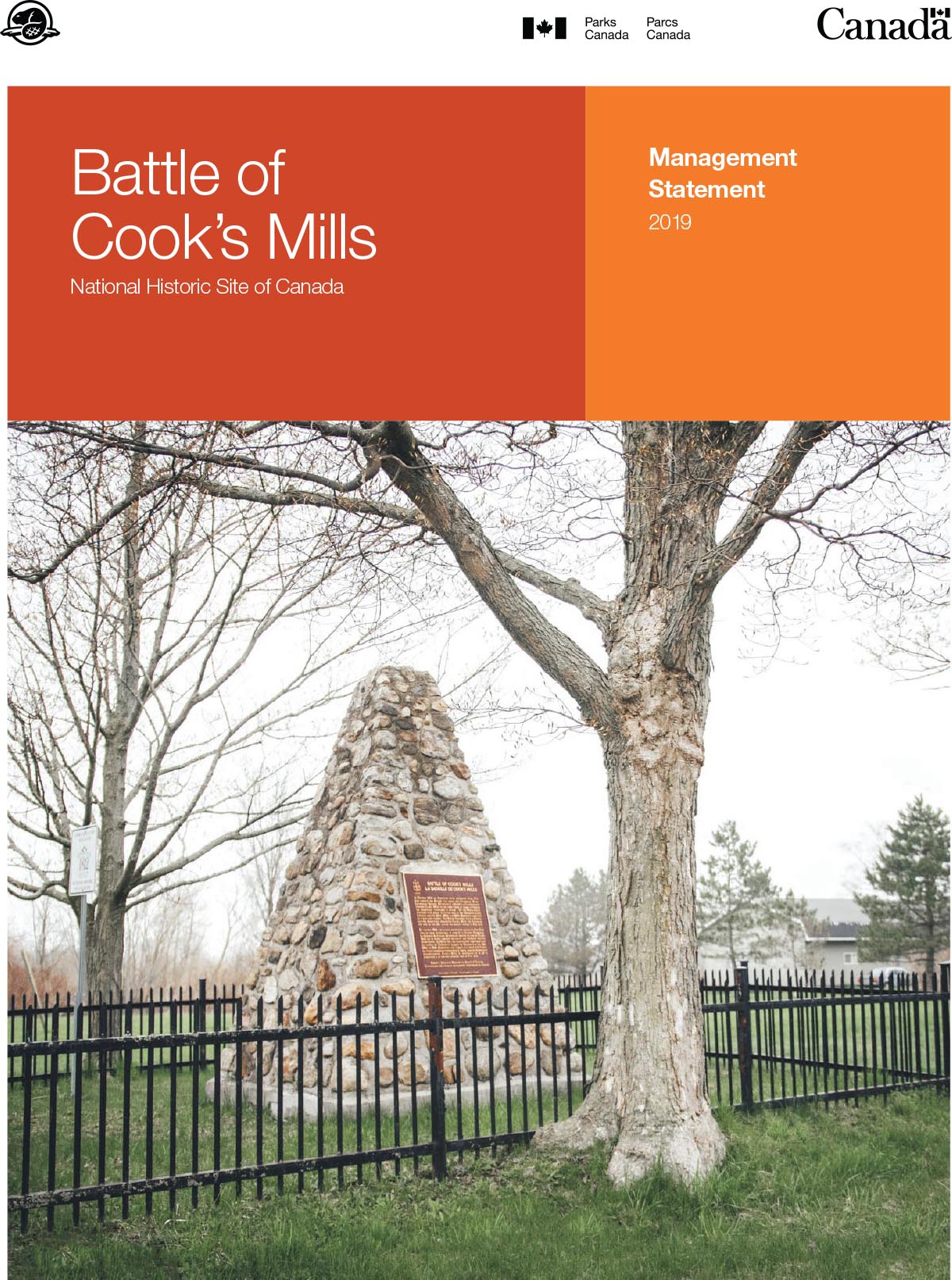Battle of Cook's Mills National Historic Site of Canada Management Statement 2019
Battle of Cook's Mills National Historic Site
Table of contents

© Her Majesty the Queen in Right of Canada, represented by the Chief Executive Officer of Parks Canada, 2019
Cette publication est aussi disponible en français :
Énoncé de gestion du lieu historique national de la Bataille-de-Cook's Mills, 2019
For more information about the management statement or about Battle of Cook's Mills National Historic Site of Canada:
Southwestern Ontario Field Unit — Parks Canada
440 King St. PO Box 321
Niagara on the Lake, ON L0S 1J0
Canada
Approval
Approved by:
Louis R. Lavoie
Field Unit Superintendent
Southwestern Ontario Field Unit
Parks Canada
Introduction
The Parks Canada Agency manages one of the finest and most extensive systems of protected natural and historic areas in the world. The Agency’s mandate is to protect and present these places for the benefit and enjoyment of current and future generations. This management statement outlines Parks Canada’s management approach and objectives for Battle of Cook’s Mills National Historic Site.
The Battle of Cook's Mills National Historic Site is a rolling semi-rural landscape east of the Welland Canal bordering the north bank of Lyon’s Creek in the City of Welland, Ontario. It was the site of an engagement between British and Canadian troops and American forces during the War of 1812. After his unsuccessful siege of Fort Erie, Lieutenant-General Gordon Drummond withdrew north and concentrated his army along the Chippawa River. In October 1814, American forces under Major-General George Izard advanced northwards. On October 18 Izard ordered Brigadier General Bissell with a force of about 900 men to march to Cook's Mills, a British outpost, to seize provisions in the form of wheat intended for British troops. On October 19, at Cook's Mills, a heavy skirmish took place, involving men of the Glengarry Light Infantry and the 82nd, 100th and 104th Regiments. Led by Lieutenant-Colonel Christopher Myers, the British and Canadian troops succeeded in their objective of assessing the American forces so that Drummond could take appropriate action. Having accomplished their reconnaissance in force they withdrew in good order. Bissel also accomplished his mission of destroying the wheat stored at the mills after which he and his men withdrew to join the main American force. Shortly afterwards the Americans destroyed Fort Erie and re-crossed the Niagara River to go into winter quarters.
Management approach
There are no known extant remains of the battle; however, a cairn and plaque erected by the Historic Sites and Monuments Board of Canada in 1977 marks the south-west corner of the battle site. Official recognition refers to the designated polygon north of Lyon's Creek. This is an unmanned site, the interpretive messaging is presented by the plaque.
Management objectives
Resource conservation
Parks Canada protects cultural resources at its heritage places in accordance with its Cultural Resource Management Policy and the Standards and Guidelines for the Conservation of Historic Places in Canada. This includes basic monitoring of the state of cultural resources, and documentation of interventions at the cairn site. The Battle of Cook’s Mills NHS was established in 1921 in recognition of the historic engagement. Parks Canada’s primary management objectives are:
- To protect the historic and archeological characteristics of the cairn site of the Battle of Cook’s Mills.
- To protect the cultural heritage associated with the location on the north side of Lyon’s Creek, a tributary of the Chippawa River, used by Drummond as a defensive position during the battle that now forms part of the designated place.
Visitor safety
Parks Canada puts appropriate measures in place to protect the health and safety of visitors to the cairn site.
Site maintenance
Parks Canada maintains a relationship with the municipality to cut the grass on the property so as to respect the site’s heritage values, present a positive image to the public, and reflect the Parks Canada brand.
Public understanding and appreciation
Parks Canada provides information about the significance of the Battle of Cook’s Mills on its website, and on the Canadian Register of Historic Places to encourage visitor and local appreciation, understanding and enjoyment of the heritage of the site.
Links
For more information, please contact:
- Date modified :